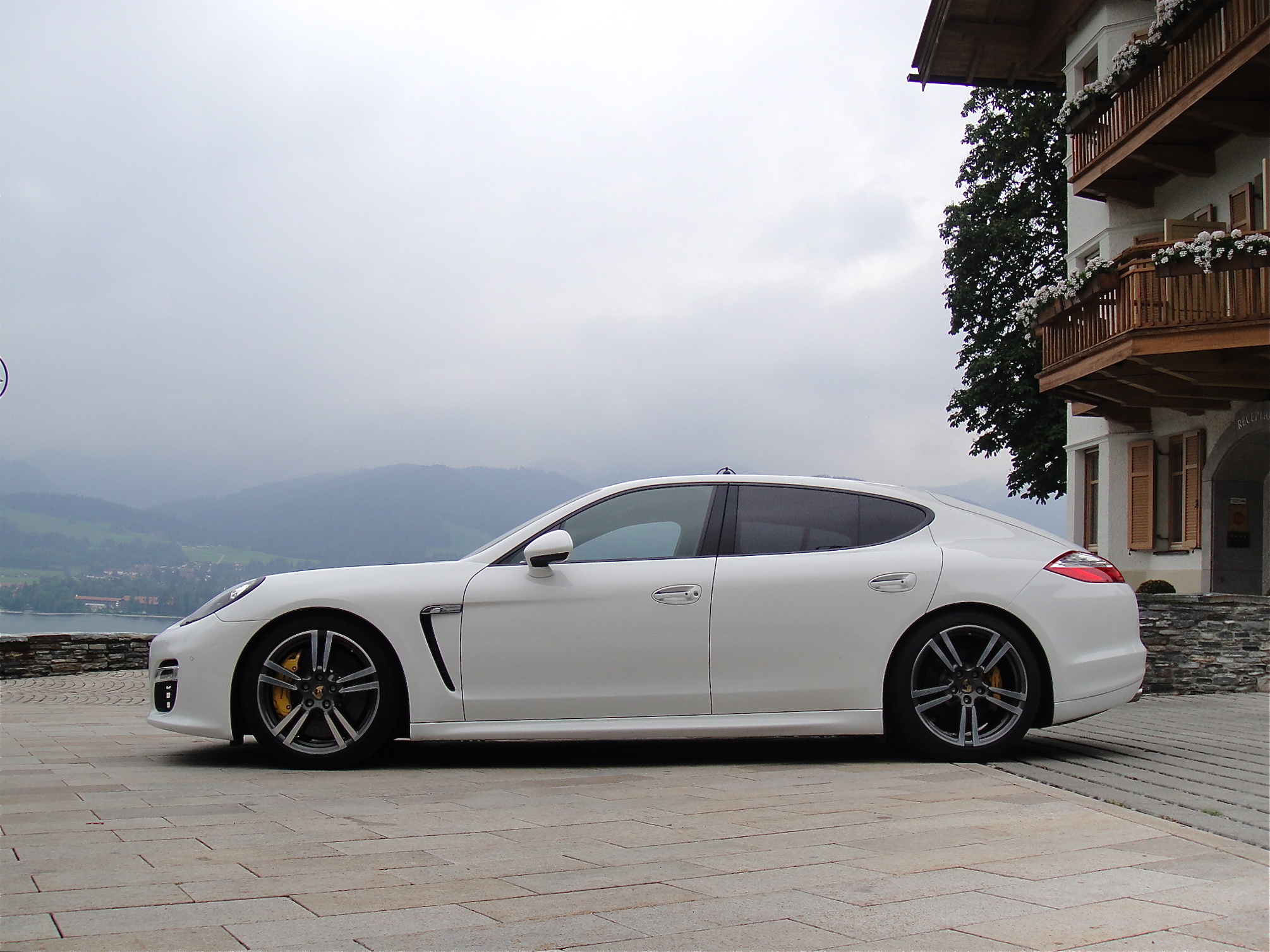First Drive: 2012 Porsche Panamera Turbo S
 Super Sedan
Super Sedan
Adding an “S” to Porsche’s toprung Panamera Turbo creates the world’s highest-performing four-door
By John LeBlanc
MUNICH, GERMANY — Porsche doesn’t have a skunk works performance group, like BMW’s M division or Mercedes-Benz’s AMG group. Porschephiles know, though, whether it’s a Boxster roadster or a Cayenne sports-utility-vehicle, that the addition of a capital letter “S” to any model’s name suggests good things for high performance junkies.
So the expectations run high with the debut of the new range-topping 2012 Panamera Turbo S. In the face of outcries of blasphemy from purists, the Panamera — Porsche’s first-ever four-door, four-passenger luxury sedan/hatchback — quickly became a global sales success after its debut for 2010. In Canada, so far this year, the Panamera sits third behind the soon-to-be-updated 911 Carrera 2+2 and the best-selling Cayenne in overall sales. In some markets, though, like the United States and China, the Porsche luxury sedan has become Porsche’s top-selling model, mainly as an alternative to traditional luxobarge sedans like the Audi A8, BMW 7 Series, Jaguar XJ and Mercedes-Benz S Class.
Atop the Porsche four-door’s lineup that includes naturally aspirated six- and eight-cylinder engines, a gasoline-electric hybrid, available rear- or all-wheel-drive and the twin-turbocharged Turbo, the new top dog Panamera Turbo S is priced appropriately, starting at $198,100. For a $41,800 premium over a “regular” Panamera Turbo, Porsche has made a lot of former options standard on the S iteration, plus added some newfound pieces of high-tech to justify its flagship standing and the company’s claim that it’s the best performing four-door you can buy. Porsche’s Dynamic Chassis Control anti-sway system, a Powerkit that adds 40 horsepower to the Turbo’s 500 rating, the Sports Chronograph package with launch control, Sport steering wheel with paddle shifters and sport exhaust, and the 911 Turbo’s Torque Vectoring Plus rear differential are all standard.
However, the more obvious reasons to get a Panamera Turbo with the additional S on its metal rump are the monumental performance numbers it generates from its twin-turbo 4.8-litre V8. Porsche says that the Panamera Turbo S’s pair of new turbos come with 40 per cent lighter turbines. They now spin quicker than the previous ones, which means you get a response that’s about a third faster when you put your foot down. Plus there’s a revised engine management system that features “over-boost.”
While the Panamera Turbo S makes an impressive 550 hp (only 10 more than a Turbo with the optional Powerkit), the new model’s 553 ft.-lb. of torque, and Earth-rotating 590 with the over boost engaged, is 37 and 74 lb.-ft. more, respectively, than the cooking Turbo. Using launch control, and aided by the Panamera Turbo S’s mandatory swift shifting seven-speed dual-clutch automatic transmission, naught to 100 km arrives in only 3.8 seconds — 0.2 quicker than a similarly equipped non-S Turbo — with top speed nominally increasing from 303 to 309 km/h. But the real eye-opener is the top line Panamera’s 0 to 200 km/h time of 12.9 seconds; not only 0.8 seconds faster than the non-S Turbo but also quicker than a 911 Turbo from only few years ago.
While the potential to drive up to 300 km/h back home in Canada seems like either suicide or criminal, it’s a reality in some parts of the unrestricted German autobahn. And in this environment, the Panamera Turbo S is a good excuse for its owners to park the private jet. Riding the endless wave of newfound mid-range torque, I only had the nerve to get the Porsche’s speedometer to indicate about 240 km/h. All the while, it was eerily quiet and stable inside. Too bad Porsche’s excellent Ceramic Composite Brake system isn’t standard. The requirement for all-season rubber in North America means the $10,100 package is an almost obligatory option.
At nearly five metres in length, the Panamera is only slightly shorter than an S Class, and as wide as a Cayenne. Yet Porsche’s Dynamic Chassis Control that hydraulically “twists” anti-sway bars for up to 1 G of lateral acceleration delivers a relatively nimble feeling by keeping the car’s tires in better contact with the road. Meanwhile, the torque vectoring system’s rear differential clutch moves from left to right and right to left. It helps the Turbo S feel more agile than any other Panamera, with lots of grip in reserve to push the car even more precisely. I’d pay the extra money just for the Turbo S’s standard paddle shifters. They’re demonstrably more intuitive than the steering wheel spoke-mounted buttons the original Turbo came with.
A newly exclusive longitudinal and lateral acceleration display can be found in the driver’s instrumentation. Other than that, there’s little to distinguish the interior of the new Turbo S. The exterior is just as subtle, the main difference is a newly styled front-end clip.
So: Is the new Panamera Turbo S worth its price premium over a regular Turbo? If you took a regular Panamera Turbo, and added all the Turbo S’s standard kit, you’d come in at about $206,000 grand — and still be short in the performance department. Just tell your accountant that the Panamera Turbo with an S is a bit of a bargain!
2012 Porsche Panamera Turbo S
WHAT I LIKE: Super car performance, but room for four and their luggage.
WHAT I DON’T: Non-traditional styling; few opportunities on Canada public roads to stretch its generous legs.
BASE PRICE: $198,000
ENGINE: 4.8L twin-turbocharged V8
TRANSMISSION: Seven-speed dual-clutch automatic
POWER/TORQUE: 550 hp; 553-590 lb.-ft.
EST. FUEL ECONOMY: L/100 km city, highway: 17.0, 8.4
COMPETITION: Audi S8, BMW Alpina B7, Jaguar XJ Supersport, Maserati Quattroporte S, Mercedes-Benz S 63 AMG 63/65
Comments
One Response to “First Drive: 2012 Porsche Panamera Turbo S”





![[del.icio.us]](https://www.straight-six.com/wp-content/plugins/bookmarkify/delicious.png)
![[Digg]](https://www.straight-six.com/wp-content/plugins/bookmarkify/digg.png)
![[Facebook]](https://www.straight-six.com/wp-content/plugins/bookmarkify/facebook.png)
![[Google]](https://www.straight-six.com/wp-content/plugins/bookmarkify/google.png)
![[Reddit]](https://www.straight-six.com/wp-content/plugins/bookmarkify/reddit.png)
![[StumbleUpon]](https://www.straight-six.com/wp-content/plugins/bookmarkify/stumbleupon.png)
![[Twitter]](https://www.straight-six.com/wp-content/plugins/bookmarkify/twitter.png)
![[Email]](https://www.straight-six.com/wp-content/plugins/bookmarkify/email.png)
August 16th, 2011 @ 8:24 am
[…] jump to 557 hp and 590 lb.-ft.— the same amount of torque as in the almost-twice-as-expensive Porsche Panamera Turbo S I recently […]